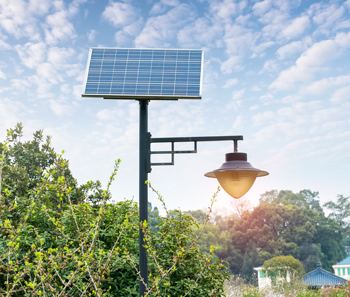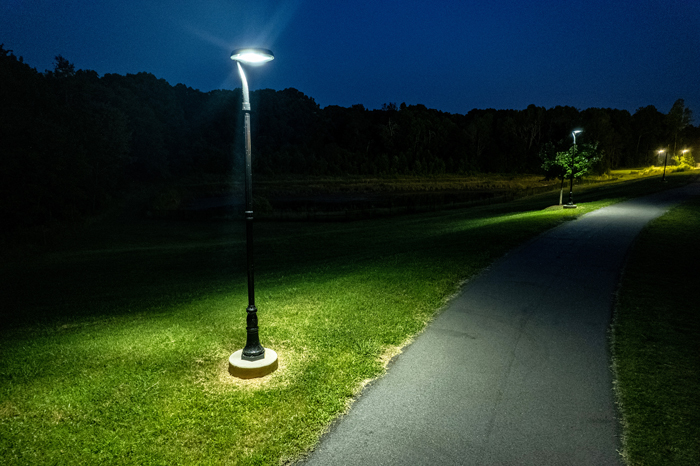Watching the action at a local park or recreation area proves that the all-ages interest in sports and wellness remains strong. Walkers circle a park in the early morning, preschoolers learn soccer in the daytime, and adult softball leagues take to the diamond after work. In many parks, these activities continue long after dusk, and drive up user numbers and satisfaction, with the help of lights.
Lighting in parks and recreation areas increases access to sports fields, walking paths and other amenities by extending the hours that residents can use these places. More safety, increased revenue and happy customers are also powerful ancillary benefits from outdoor lighting.
But installing these fixtures requires complex planning, can disturb landscaping and other features, and may see opposition from park neighbors who do not want a new source of glare coming into their living rooms.
Parks administrators, long used to balancing the needs of users, may find that talk of adding outdoor lighting brings the community—and multiple opinions—out as well. Sports teams may argue that increasing field-use time will mean more kids get to play. There are some, conversely, who believe light pollution is an issue for people and wildlife. The desire to provide safe facilities can lead to the installation of lights outside of long-term or masterplanning of an area. And there are always mandates that projects need to be cost effective, environmentally friendly and aesthetically pleasing.
These often-competing factors make recreation lighting a challenge for parks administrators.

“A lot of outdoor lighting is inefficient, overly bright, poorly targeted, improperly shielded and, in many cases, completely unnecessary,” said Lauren Scorzafava with the International Dark-Sky Association, a group that works to reduce light pollution and promote responsible outdoor lighting.
The end goal is for park users to not notice the lighting at all, according to Royce Banuelos of a Houston-based lighting manufacturer.
The Cost of Bad Lighting
When the lighting isn’t right on a baseball field or on a facility sign, users do notice. They miss catches or driveways, and may feel less safe.
What isn’t often noticed is how too much light or the wrong lighting wastes energy and money, increases light pollution, and disrupts wildlife in the area, according to Scorzafava.
“We recognize modern society requires outdoor lighting for a variety of needs and are not suggesting that people turn all of the lights off—just that we use light more thoughtfully and intentionally in order to minimize the negative effects of light pollution,” she said.
The International Dark-Sky Association (IDA) and Illuminating Engineering Society (IES) offer Five Principles for Responsible Outdoor Lighting:
- All light should have a clear purpose.
- Light should be directed only where it is needed.
- Light should be no brighter than necessary.
- Light should be controlled with motion sensors, timers or other controls to ensure that it is only used when needed, dimmed when possible and off when it’s not useful.
- Light should be as warm a color temperature as possible to limit the amount of shorter wavelength (blue-violet) light.
And while more lights are often associated with more safety, bad lighting can be a safety issue as well. Banuelos recalled a badminton club that wanted to replace an outdoor sign. To cut costs, the club first went with floodlights that saved money but did not properly cast the light on the sign. This becomes a safety issue when cars miss turns or do not see pedestrians because a light is misdirected.
Don Bennett, director of sales for a lighting manufacturer based in Norcross, Ga., said light panels should shine down, not out. This reduces glare and lights only what needs to be seen.
The Benefit of Experience
Parks administrators are experts on many things, but lighting is likely not one of them.
Banuelos said lighting suppliers can start the conversation on the right path by using terms that parks officials already know. “We start with language they are familiar with: ‘bright’ or ‘white’ or ‘blinding.’” he said.
You don’t want blinding lights in baseball, for example, and you do want light that distributes well on a sign.
He recalled a client in Houston that had a large baseball facility to light. The plan the client developed resulted in some places in the park being too “hot” and some too dim. Representatives went to the field, took photos and re-created a better layout.
One development that has led to more, but worse, lighting situations is that adding lighting “has become so inexpensive that it is used indiscriminately, minimizing any energy and money savings that would otherwise come from improved energy efficiency,” said Scorzafava.
While every recreation facility is eager and often expected to reduce its impact on the environment, doing so requires a learning curve as well as a company that knows the latest technology.
Light and motion detectors save money and electricity, but Banuelos said incorrect wiring between the photocell detector and main circuitry can frustrate the park employees who have to deal with lights that either don’t go on or don’t stay on. Project managers should rely on their lighting vendor to explain and alleviate potential installation issues.
Bennett said his company stays up-to-date on new developments in solar lighting, which includes knowing that each facility may have different state or local requirements for issues such as battery recycling.
Innovation and Installation
Bennett said the solar option may alleviate the need to tear up concrete and landscaping to install the infrastructure for wired electric power.
“Some want to forgo electrical all together to save on digging and trenching. This makes for a quick installation because no infrastructure is needed. You can place these lights where you choose,” he said.
For new facilities, solar allows for a design flexibility that hard-wired fixtures often can’t offer. Solar panels can be integrated into the fixture, which means officials can often go with a beautifully designed unit where they may have had little choice before.
And the problem solving will continue, Bennett said.
He predicts more compact, lighter batteries, and better
LED bulbs.
He is also excited about innovations in shaping solar panels in cast aluminum to better blend into the landscape.
According to Scorzafava, a bright future is one where “light is only used where and when it is needed in the amount it is needed and as warm as possible, leading to reduced light pollution, improved energy and money savings, improved safety, and reduced harm to human health and biodiversity. Plus, installations that follow these principles will be more aesthetically pleasing.”
She added, “By applying these principles, properly designed electric lighting at night can be beautiful, healthy and functional.” RM



